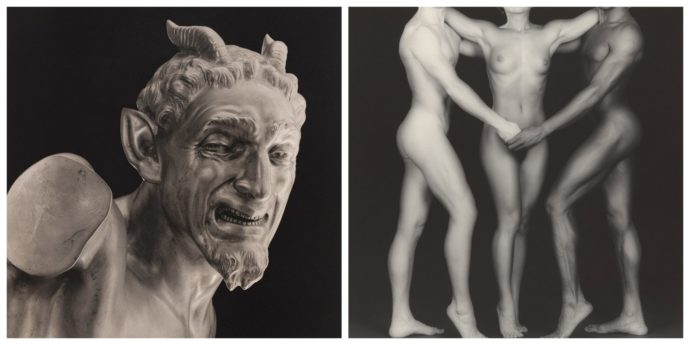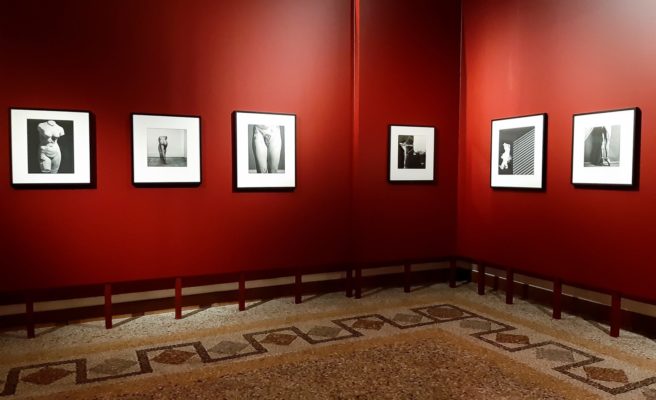First impressions of the exhibition in Rome
Thirty years after his death, the world is celebrating one of the most appreciated yet controversial photographers in history: Robert Mapplethorpe (1946-1989). Born in Floral Park (Queens) his black and white portraits, still life and images of extreme sexual scenes marked the art of the twentieth century.
In the 60s Mapplethorpe studied drawing, painting and sculpture at Pratt Institute, in nearby Brooklyn. Influenced by artists such as Joseph Cornell and Marcel Duchamp, he also experimented with different materials in mixed-media collage. In 1966 he met Patti Smith and three years later the two moved into the Chelsea Hotel. In 1970 Mapplethorpe acquired a Polaroid camera from artist and filmmaker Sandy Daley and began producing his own photos to incorporate into the collages. In 1975, Mapplethorpe moved on to Hasselblad camera, leaving permanently the immediacy of Polaroids: from the 80s on he started working almost exclusively in the studio, shooting photographs with incredible attention to detail.
Mapplethorpe’s aestethic had a deep impact on New York’s artistic scene in the 70s: he dignified gay culture and gave voice to the complex universe of desire. His photos have been compared to the works of artists like Michelangelo, Hendrick Goltzius and August Rodin, with whom he shared the obsession for balance and symmetry.
His works are currently being displayed in Edinburgh (Scotland), Rome (Italy) and New York (U.S.A.) in three different exhibitions: ARTISTS ROOM Self Evidence: Woodman, Arbus and Mapplethorpe at the Scottish National Portrait Gallery, Robert Mapplethorpe: The Sensitive Lens (L’obiettivo Sensibile) at Galleria Corsini and Implicit Tensions: Mapplethorpe Now at Solomon R. Guggenheim Museum.

I’ve recently visited the exhibition in Rome, which has been opened in March and it’s been extended until October 6, 2019 (it was meant to close in June). This is maybe the most interesting yet shocking set-up for Mapplethorpe’s works because it’s the first time that his photos are being shown in a gallery which includes a huge collection of eighteenth century paintings. The collection was put together by Cardinal Neri Maria Corsini (1685-1770), who also lived in Palazzo Corsini from 1738 until his death.
The exhibition itinerary starts from the fact that Mapplethorpe was also a collector: from 1973 on, collecting historical photos and objects became an essential element to define his sense of aesthetic. Mapplethorpe and his late partner, art historian and curator Sam Wagstaff (1921-1987), became two of the most influential collectors in the world. The photographer used to say that if he had lived a few centuries earlier, he might have been a sculptor and that photography was another way to make sculpture: from the people he portrayed to the objects, they were all figures carved in stone.

The Sensitive Lens includes 45 photos, which focus on the main themes of his work: classic statuary, Renaissance’s composition and the study of still life. The exhibition itself is quite confusing: the first photos, Winter Landscape (1979), Italian Devil (1988) and Ken and Lydia and Tyler (1985) are individually isolated inside rooms filled with ancient paintings, so it’s quite difficult to look for those black and whites in the surrounding explosion of colors. Once you find the photos (and if you know the Corsini Collection) you can appreciate the coherence of the set-up: Winter Landscape is located right above another landscape (the one with Rinaldo and Armida by Gaspard Dughet), Italian Devil portrays one of the many sculptures in Mapplethorpe’s collection and Ken and Lydia and Tyler is a new take on The Three Graces; so both these works are somehow consistent with the classic paintings in the rooms. However, as you follow the itinerary, things get worse: it’s hard to find a logic when you see sadomasochistic scenes like Dominick and Elliot (1979) or Lisa Lyon (1981) next to aristocrats portraits and sacred representations.
Paradoxically, the final and “shocking” part of the exhibition is also the most enjoyable: in the last two rooms most of Mapplethorpe’s works are displayed alone, on a burgundy red wall, as they should have been since the beginning. Here, sculptures, flowers and explicit sexual contents find their perfect arrangement, as they can be admired in their ease and excesses. With no distractions, we can fully appreciate Mapplethorpe’s art and his incredible mastery of black and white.
Robert Mapplethorpe | The Sensitive Lens
Dates: March 15 – October 6, 2019
Location: Rome, Galleria Corsini
Opening hours: Tuesday-Sunday 8:30 am-7:00pm





